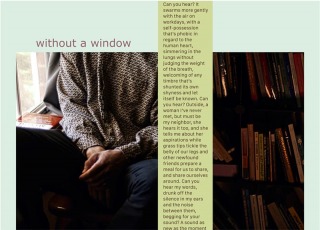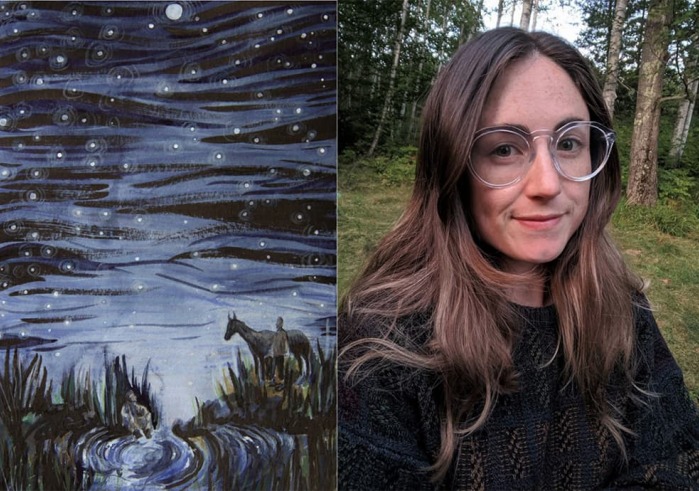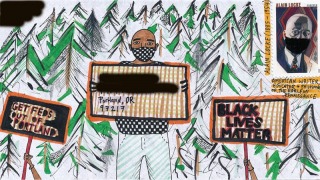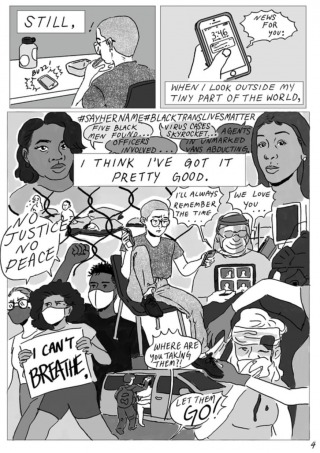
Not Cancelled 2020: Celebrating Creativity in the Midst of Chaos

Early this year, as event after event was being called off because of the pandemic, Nina Boutin ‘17 decided she wanted to prove that some things cannot be cancelled.
Boutin, a freelance artist, got in touch with Professor Oleg Gelikman and together they came up with the idea for Not Cancelled 2020. The online art exhibit is a collaborative project where students and alumni can channel their creative energies while quarantined. Boutin, currently working remotely for the Caravan Stage Company, knew that many people were feeling the weight of the moment and were compelled to create. She wanted to identify the common threads among projects and create a space for ideas to interact.
Boutin reached out to students and alumni on social media, asking them to share personal art projects. “For me, it felt like a meaningful way to create community during a weird and difficult time,” Boutin said. “Even though I was stuck at home alone, I felt I was working in solidarity with my peers.”
It can be scary to share your artwork publicly and make yourself vulnerable, but many in the Soka humanities community answered the Not Cancelled 2020 call. In September, a website was published to showcase pieces by nine students and alumni, ranging from the class of 2016 to the class of 2021.
Unlike the trite advertising message of “we’re stronger when we’re apart,” the Not Cancelled 2020 space doesn’t impose a false story of happiness. It documents the reality we’re living, including moments of frustration, stress, or helplessness we may feel. The exhibit shows that while the pandemic has taken so much from our lives, it has also allowed for self-reflection and growth.

Jordan Lindsey ’17, one of the featured artists, is a doctoral student in communication and culture at Howard University, currently living in Washington, D.C.. He spends his free time writing poetry and short fiction, taking photos, and making music. Since the beginning of the pandemic, he’s struggled to express the tension he feels both internally and externally.
These tensions materialize in the series of illustrated prose poems Lindsey created for Not Cancelled 2020. Each aspect of their composition—color, structure, and visual and verbal content—comes together to create a sense of space for the audience to relate to.
“I think the pandemic tested my ability to convey emotions and feelings I hadn’t finished grappling with in a way that was somehow coherent and structured,” Lindsey said. “My piece was a way for me to try and think about/illustrate the tensions taking place inside and outside of myself during this time with words and visuals. Things like the irony of feeling lonely in your own home, but also enjoying the calmness from people’s absence in public spaces.”
Rosabelle Heine ’20, whose founding of Soka’s first podcast and community radio club led to her job as a podcast editor and producer, created a mail art project for the exhibition. “Handle with Care” was inspired by her capstone “Secrets, Letters and Social Practice Art: Self-Presentation in the Internet Age.”

“For the past several months, most of my interactions have been through a screen,” she said. “I wanted to return to the simplicity and constancy of letter-writing during a time when nothing felt simple or constant. I also wanted to escape the echo-chamber of my Instagram feed where everyone I follow and everyone who follows me is posting similarly. If I send a letter that displays a message, someone new (i.e., a USPS worker) might see it. This project was also a feeble attempt to support the US Postal Service in a period of crisis.”
Many of the envelopes depict scenes related to the pandemic or our current circumstances. One shows a series of faces with tan lines from a mask, another shows people touching beneath the caption “things to look forward to.” Some letters address USPS workers, while others depict distance between friends and loved ones or the Black Lives Matter movement. The art is intended both for the recipient of the letter and the worker delivering the letter.
In a time where someone’s entire day is spent looking at a screen, writing or receiving a handmade letter in the mail can create a deeper connection than an electronic message. For Heine, mail art was a way to express creativity and create community at the same time.
Rina Lindenmayer ’19, who works at a secondhand bookstore in their hometown of Gaithersburg, Maryland, created a short comic exploring their personal anxiety working full time amid quarantine precautions and a helplessness they felt regarding current issues we’re facing, including police brutality and the global pandemic.

“I feel that the pandemic has caused a shared anxiety within our communities and our country, exacerbated by the many social and political issues that have been continually brought to our attention within the year,” Lindenmayer said. “I was inspired to create work that reflects this commonality of discomfort in order to remind ourselves that we are not alone.”
Like Lindenmayer, Boutin felt a need to create to fill an emptiness, something she found to be both exciting and terrifying. Her watercolor paintings can be seen as meditations surrounding a novel, Chevengur, by Andrei Platonov, written in the aftermath of the Russian Revolution. She was inspired by Platonov’s vision of community and his intense care for all that have been forgotten and oppressed. As she finished the series, she realized that her work was “more about the movement of grief, the weight of loss, and the necessity of mourning loss collectively rather than individually.”
With school, work, and even doctor’s visits being conducted from our homes these days, it can be hard to stay motivated, let alone be creative. Boutin’s secret? “I force myself to spend time with my art everyday, even if I don’t want to,” she said. “It’s my way of giving my art agency as well as keeping my momentum going so I never feel stuck. I find that my art grows from these moments of exhaustion and feeling like I have to give up, so if I just keep at it and wait until that moment comes, the next moment will be the creative spark.”
—Nagisa Smalheiser ’21
